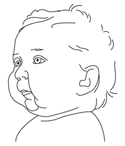Children's Emergency Department is now located in Children's Tower: 1001 E. Marshall Street.
Learn more
PRS can occur by itself or as part of a genetic syndrome (a disorder with more than one identifying symptom or affected area). It is extremely important for an infant with PRS to see a geneticist (a medical doctor who specialists in conditions passed from parents to a child). The geneticist will check if PRS is part of a syndrome or the only thing found. We will help set up this appointment for you.
The exact cause of PRS is not known. Certain factors which crowd the fetus may cause problems with the growth of the lower jaw. Some conditions related to the nervous system lead to decreased jaw movement while the baby is in the womb and can lead to PRS. There are also studies that demonstrate a genetic basis for PRS.
Breathing - The most important concern for babies with PRS is safe breathing. When a baby with PRS lies on their back, their tongue may fall back and block the airway at the back of the throat. How much a child’s breathing is affected depends on the severity of PRS. If PRS is very mild, there may be no airway concerns. As the severity increases, so do the concerns for safe breathing.
A baby with mild PRS and no or few airway problems usually does well if positioned on their stomach as this allows the tongue to fall forward out of the airway. If this positioning does not work, the baby may need to try a nasal trumpet. This is a small tube placed in the nose to improve airflow into the upper airway. When effective, a nasal trumped can help a child avoid surgery.
More severe forms of PRS may need surgery to help the baby breathe. If there are no other problems with the structure of the airway, there are several surgical options available for this. One option is a procedure that lengthens the lower jaw to open the airway.
Because multiple related issues may need to be addressed, an evaluation by a craniofacial surgeon is needed to be sure a child gets the best treatment option. For babies who have other problems in their lower airway, surgery to create an opening in the neck for a breathing tube may be needed. If the baby has a cleft palate [LINK to cleft palate page], surgery to close the palate usually occurs around the time a child turns one year of age.
Feeding – A baby must be able to breathe well in order to feed. Any breathing or airway problems must be addressed before a baby can feed effectively. Sometimes, holding your baby in special positions may help with feeding. If a baby has a cleft palate, feeding with specialized bottles and nipples is very helpful. Feeding strategies like those used for babies with cleft palate can help establish good feeding. Our team also offers feeding consultation services.
If feeding remains a problem, other ways of getting nutrition, such as a nasogastric (NG) tube, may be needed. This is a small tube passed through the nose into the stomach. In rare cases, a baby may require a gastrostomy tube, which is a tube surgically placed through the belly into the stomach for nutrition. Most children with PRS outgrow their feeding problems by one to two years of age.
Taking care of a child with PRS is more than just performing surgical procedures. It requires very close follow-up. Having PRS can affect a child’s appearance, self-esteem, feeding, teeth, hearing and speech. This is why all children with PRS are followed regularly by our multidisciplinary team. Experts dedicated to the care of children with craniofacial conditions from a wide range of pediatric specialties work together on this team to make sure children receive the best care possible.